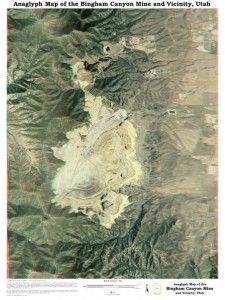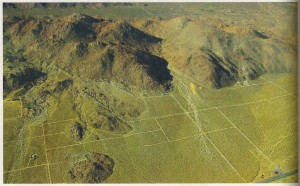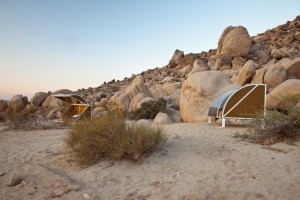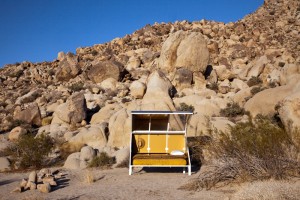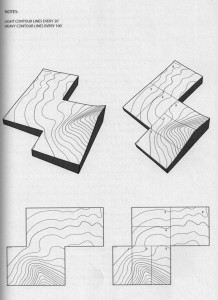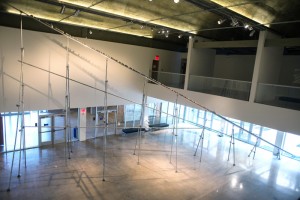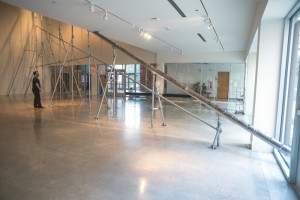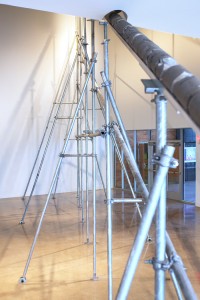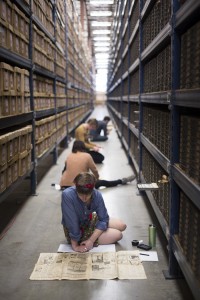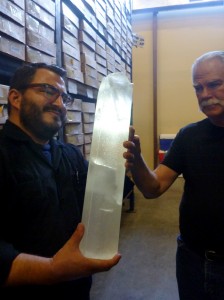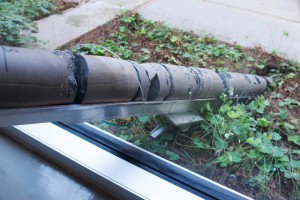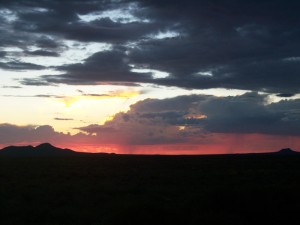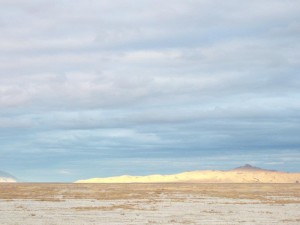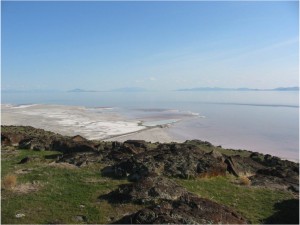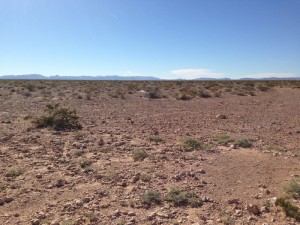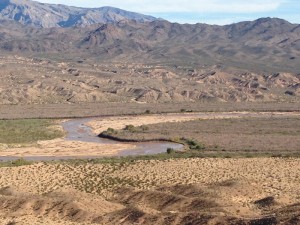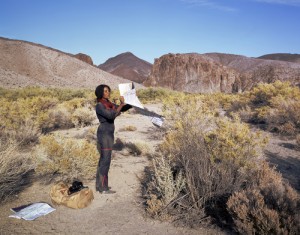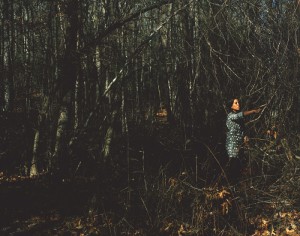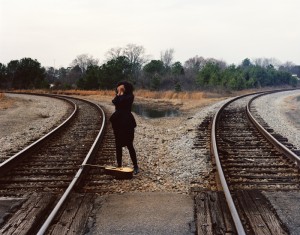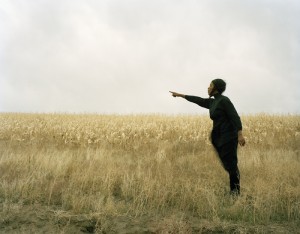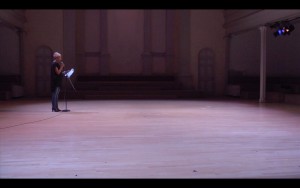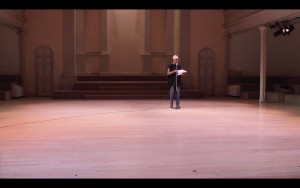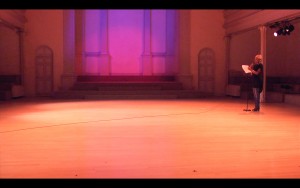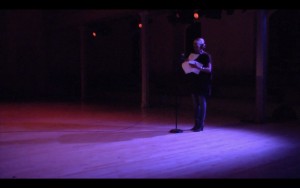04 01
04_01
DOWNLOAD PDF: Site95_Journal_04_01.E
Curated by Cara Despain
Editor in Chief Meaghan Kent, Contributing Editor Janet Kim, Copy Editor Beth Maycumber, Copy Editor Jennifer Soosaar
Contributions by David Brooks, Bonnie Despain, Hikmet Sidney Loe, and Xaviera Simmons.
With support from Marjorie and Douglas Miller
Cover: Anaglyph Map of the Bingham Canyon Mine and Vicinity, Utah, Image courtesy of 2i3d Stereo Imaging, Utah
Prospect by Cara Despain
It’s quite a thing to see the sea meet the sky: two profoundly different systems converging at a single line. With nothing but water and atmosphere, this seems the true way to understand the planet’s shape—after all, its surface is comprised mostly of these materials. No wonder there was a period of second-guessing the spherical model. There’s no real way to intuit that you might actually be standing sideways on an immense conglomerate ball of interstellar material, bound only by gravity. That really can only be (abstractly) understood when you see the Earth from an external perspective—one that looks different than yours from the ground; something like what the Charles and Ray Eames’ Powers of Ten film illustrates. From this baseline—sea level, maximum flatness—the physical character of the Earth’s landmasses is increasingly complex. Geologic forces have created, destroyed and ultimately sculpted the topography that contains every last landscape the history of art could possibly romantically depict. But this came after the practical effect those topographies had on migration, settlement and ultimately culture. You can look at things like tools, clothing, transportation modes, biological adaptation and shelter and locate peoples’ history in landscape. That is the larger story. Does any of this formation resound in the practices of artists now at different elevations? Excavating and sifting histories, tracing influences, and drawing lineages is like panning for gold. Patience, trained eyesight, and a determination to make the trek are requisite. In the context of current human existence, one that is free floating in an increasingly gravity-less, shapeless world—the liminal zone of endless images, links and information of the Internet and the infinite sub-microcosms that ensue—discerning such distinctions and characteristics is difficult. Living in non-space as much as we do, especially in the art world where, on top of spending so much time in nondescript white and concrete (often windowless) interiors, we absorb content such as installation views, reviews, and Instagram images of other art shows instantaneously, we are bound to start to lose some colloquial sense of location. These are places largely without a relationship to a physical place. How do you understand the ground without walking on it?
I was born and raised at approximately 5,000 feet, nestled in the Rocky Mountains of Utah, and I now reside at an altitude of zero feet, surrounded by the sky and ocean in Florida. The difficulty and reward in conquering the western American frontier was the Rockies. They were hard to cross and striking to observe, and inspired scores of landscape painting and photography traditions—which only perpetuated exploration and the underlying promise of proprietorship. Transiting tough passages in covered wagons certainly had a lasting impact on culture—the resulting Mormon Pioneer folk music has an entire history all its own, for example, and certain kinds of folk aesthetics related to craft and function have persisted in the West generally, and morphed into new forms with the passage of time. Now many of those same forged routes are permanently etched into the land in the form of road cuts made for highways, solidifying our presence and easing our ability to travel freely without having to make many terrain-based considerations. In Florida, elevation had to be constructed. The southernmost tip of the state is sub-tropical swampland that despite the year-round temperate weather was rather inhospitable for settlement. Natives would build up mounds out of discarded shells and bones to raise themselves above the water level. This conceivably also would offer more prospecting possibility. Though the necessity and intention was quite different, the modern, paradise-seeking settlers that followed in the wake of the Standard Oil industrialist Henry Flagler followed suit. Today, to obtain a view in South Florida you must have access or class, as high-rise condos stand as the tallest landmarks in the modern landscape. Going from a varied terrain where the effects of gravity, erosion, and scale are unavoidable to a place defined by its unrelenting flatness, I think a lot about the specific subject of topography. I hear a difference in the music bands play, and see a difference in the architecture and lifestyle. As an offshoot of my interest in regionalism in contemporary art and aesthetics, I wanted to look at the role the actual shape of the land might play. As a topic for this Journal, it is a focused but widely inclusive receptacle for histories and perspectives as they relate to culture and its attendant objects and artifacts. Physical topographies belie social topographies, and the view shifts with the vantage point.
Within topography and elevation exist many corollaries to culture; those cannot all be tackled here. I hope to offer a few examples that come naturally, and look at a practical dimension of landscape that shifts and extends the conversation to relate to deep time, geology and our experience in that continuum. All of the contributors I have invited have a practice that is deeply outdoors, and this means what they experience out there becomes a part of their artwork and expertise. When indoors, Hikmet Sidney Loe lectures regularly on the Land art of the American West, but this is informed by firsthand, sometimes disorienting and difficult jaunts. David Brooks, an artist/naturalist hybrid whose research locales have spanned Africa, the Everglades and the Amazon, offers a discussion that probes a compressed and buried ancient topography of the oil-laden lands of Texas. Xaviera Simmons has traveled different migration routes by foot, taking her all over the world, and additionally has worked remotely to capture many of the landscapes that comprise or inform her works. Physically transiting landscapes means dealing with the reality of those places, not just interpreting them as pictures—which are two vastly different types of engagement that can be historically evidenced where depicting landscape and the sublime are concerned. The intention here is to go deeper into contemporary notions of landscape by simplification—perhaps in part by just talking about being there.
Altitude alone has biological implications: it has affected the pulmonary development of different peoples (such as high-altitude Andean cultures) and, as recent research by a University of Utah neuroscientist comparing suicide rates in high-altitude regions even suggests, it continues to have an impact on brain chemistry because of the difference in oxygen levels at different elevations. You may reference the timberline to further illustrate the effect of high elevation on life. Altitude and topography also have evolutionary implications: avoiding predators, locating resources or taking refuge often relies on prospecting from higher ground. These implications fold into social impacts: mountains meant a vantage point, shelter, resources and, for those who prospected in another sense, the promise of fortune. Even some American folk songs originating in the South morphed as those that sang them traveled over different terrain and altered the lyrics to reflect a new experience set to an older melody.
I was thinking about how settling and living in the iconic rugged lands of the West was the ultimate conclusion to prospecting when I visited “High Desert Test Sites” and stayed in the “Wagon Station Encampment” in November of 2014, part of Andrea Zittel’s “A-Z West” project in Joshua Tree, California. Starting with a property containing an old homestead structure, Zittel gradually acquired adjacent parcels of land bordering Joshua Tree National Park and Bureau of Land Management property. An artist whose practice is deeply centered on her experience on her land, Zittel has constructed a kind of open commune that also facilitates other artists, writers, and land enthusiasts who want to learn by experience. Living remotely in the desert, as she has done for nearly fifteen years, has enabled her to distill her interest in lived experience and largely unhinge it from symbolic objects and allowed her to realize a functional living practice that abides by her aesthetics and preferences. “A-Z West” is an experimental, active site that offers insight to her practice and life in her curated landscape, and for those who want it, participation.
I arrived to the “Wagon Station Encampment” just as the sun was setting at an early 5:30pm behind the far hill of the small canyon in which it is situated. The temperature in the beyond-arid region had dropped quickly, and there was a grating wind storm kicking invisible sand into impossible areas of my exposed face. Shelter immediately became the most pressing part of my visit. “The Wagon Stations”—wonderful modernist pods modeled after covered wagons with a 1960s sci-fi flare—dot the rocky hillside, and I was eager to choose mine and get out of the wind. The highest stations, the ones with a superior view from their position on the hill, were already spoken for so I settled my things in a station on the canyon floor—going further back in hopes of being shielded by the canyon walls. The interiors of the stations are thoughtfully designed and equipped, and have a particular desert intoned, mid-century color palette and style. Each contains a sun hat, a wooden hand broom, a list of nearby must-sees, and a sleeping pad and pillow. I quickly reverted to my outdoor mindset: I welcomed the excitement and familiarity of seeing large rocks, assessing protection, and climbing up to survey my location to orient myself there. In the morning, I was able to get the full sense of how particularly modeled the encampment is: the outdoor kitchen, showers, compost toilets, and communal living room/fire pit area all have meticulous considerations and, though outdoors, never appear disheveled. In the daylight I could see that the pods had large aluminum panels on the front that glinted brightly in the sun, further lending them an otherworldly feeling. The Plexiglas panel is situated so that when the main hatch is closed, you can see the head of the person lying inside—as though they are cryogenic freezing chambers to transport all the campers to some uncertain and strange(r) future.
The western deserts have a magical mystery to them, one that stems I think from a few factors. In relation to topography, the ability to get lost—to disappear in rocks, canyons, and mountains and be distorted and engulfed by heat waves has propagated a sort of supernatural feeling—this on top of the sheer wackiness of the rock formations themselves. Additionally, the darker history of atomic and military aircraft testing has reinforced both a skepticism and a mysticism. Arguably as a result, an entire UFO-following culture exists in the Southwest. I awoke to low and distant sonic booms that, if I had chosen to ignore this fact, would’ve seemed positively discordant. This, combined with the already extant California New Age culture, has been cultivated and manifests as a certain desert culture—one that has it own flavor of American folk qualities. This is evidenced by things like the nearby Integratron (an immaculate geodesic structure where hypnotic sound baths are held), and the oddities that can be found at the weekly swap meet, amongst many others. It exists here and in the deserts I grew up traveling around, and I have wondered if some of the early migration mentality— wide-open, go-west-to practice-what-and-how-you-wish- still persists in some of our subcultures.
In the days that followed, in addition to my research and art-making, I drove and hiked around in the surrounding area to get a sense of the land, to round corners that surely hid something spectacular or scary or ancient that was obscured from view by the boulders or mountains, and peered across the desert at every opportunity with my borrowed binoculars. And indeed on Zittel’s properties there are many artworks from previous “High Desert Test Site” projects, as well as some of those magic desert oddities, that can only be viewed by hiking in—which wouldn’t be possible without a varied landscape. In the nearby national park—a place with a particularly unique and strange topographical composition—there were several hikes that ended in panoramic views, allowing you to see for miles. There is something about being up on an outlook and being able to see across a large expanse below that turns you into the ultimate watcher, and gives you a disproportionate sense of self. I thought again about the settlement of the desert, and how it seemed that being out there, able to hide in the hills spying from your own private island was the new West. Was this a shred of our instinctual behavior—prospecting, assessing danger—showing through? Or was this an obsessive concern with who is doing what on whose property?
For Zittel, the desire for solitude in the open desert, coupled perhaps paradoxically with a desire to share the investigation of this kind of living, is the driving force behind her land purchases. In addition to pumping in water, fending off elusive but dangerous creatures, befriending neighbors, watching the Southern California suburban sprawl creep into the desert, and engaging the local fabric of people and attractions, simply working/settling/sustaining her land from the perspective of an artist is what defines her practice that she opens up to those that visit. This is somewhere beyond Land art—pieces that were placed in a landscape and remain static—or something like Donald Judd’s compound in Marfa that, even if it shares some queries and desires, was ultimately a private residence until after his death. It’s an opus that is still being created, one that others are invited to contribute to, navigate and live in. It struck me that there was in fact something happening that felt akin to time travel. The sense of infinite days and timelessness that so many Spaghetti Westerns portrayed is a reality when you step outside of the hyper-drive of the art world, and cities in general. Perhaps that is a trite sentiment, but the simplicity that is sought with “A-Z West”, and the little bubble that has been created there feels like part of a longer and bigger story that can only be told by direct observation—by living. This is being there.
Topical Topography: A Journey from the Permian Basin to the Prius by David Brooks
Imagine yourself in Central Park one million years ago. You would be standing on a vast ice sheet, a 4,000-mile glacial wall, as much as 2,000 feet thick. Alone on the vast glacier, you would not sense its slow crushing, scraping, ripping movement as it advanced south, leaving great masses of rock debris in its wake. Under the frozen depths, where the carousel now stands, you would not notice the effect on the bedrock as the glacier dragged itself along.
—Robert Smithson, Fredrick Law Olmsted and the Dialectical Landscape
I often find my perceptual capacities working in direct conflict with both my conceptual curiosities and emotional barometer when it comes to comprehending place – whether particularly or generally. Perhaps it is not until we can think outside of our momentary time and space that we can begin to ascertain the constellatory nuances of place more fully and more accurately, even if just taking a walk through Central Park.
When the director of the Visual Arts Center (VAC) at the University of Texas at Austin invited me to be an Artist-in-Residence and formulate an exhibition for the Department of Art and Art History, we discussed how the VAC has historically collaborated with other departments at UT at Austin. Being one of the country’s great research universities I knew I would be in my element. I had no preconceived idea of what would come of this precisely, until I started researching. I did know, however, that I wanted to find a meaningful way of working with the Jackson School of Geosciences because, as a northerner, when I think “Texas”, I think “oil”, as does much of the country. I wanted to take this opportunity to look beyond conventional understandings of the petroleum industry, to subvert typically didactic and dead end frameworks. There are enough people pointing their fingers at BP and their brethren in Big Oil, and my finger would not add much to that conversation. That would simply be beating a dead horse.
I wanted, rather, to expound on the material culture (literally material, e.g. rock, dirt, dust, and drills) of an industry that engages such large, vast, unfathomable, and unquantifiable scales of carbon (32 billion barrels of liquid fuels annually), time (250 million year old petroleum), money (trillion dollar revenue streams), political empowerment (enough to start wars), and its measurable but elusive atmospheric impact. To couch a conversation of climate change—it’s millennia of geo-cycles and the bellicose political climate of the day within the immovable and cumbersome presence of a rock—puts the debate into a granular perspective. This was at the core of my dilemma and at the core of my project, and this could really only be done in Texas.
At the turn of the twentieth century, long before the advent of core technology, when prospectors were looking for oil they would use rotary drilling techniques of large augers to bore into the earth’s surface, maxing out at depths around 1,000 feet. At ten-foot increments the drill would be raised back to the surface and the cuttings would be shaken off the drill tip. Those rock cuttings would be cleaned and kept in either envelopes or glass vials and catalogued in their respective sequence of depths. Their compositions would then be analyzed for various elements, including the detection of hydrocarbons indicating the presence of oil. The great oil boom of Texas was sparked when one such drill struck a reservoir at a mere 1,020 feet below the earth’s surface before it erupted into a gusher. That would be the famed “Spindletop” field of 1901, and it marked the beginning of the Oil Age. As Texas quickly advanced to being the most oil-productive state in the U.S., the country consequently overtook the Russian Empire as the top producer of petroleum at that time. So the technology of its geophysicists also advanced, paving the way for core drilling. Core technology has allowed geophysicists to extract whole five-inch diameter cylindrical cores, in lengths from three feet to 1,500 feet, and extracted from depths greater than 30,000 feet.
From the early prospecting of the Beaumont region of eastern Texas, to the heyday of the Permian Basin in Northwest Texas—as well as the current trends toward fracking the Eagle Ford Shale—the search for oil in these 250 million year old sediments has ebbed and flowed depending on economic and political factors as well as the people and personalities running the show. An aesthetic perspective of land is as malleable, topical and conflicted as is our use of that land. Biota, abiota, economies and ideologies have only become more inextricably linked as the stakes get higher and the resources become scarcer. One need only remember how the fecundity of the west fueled the rise of industrial progress under the mantra of Manifest Destiny; or how the Hudson River School’s view of North America as a garden of Eden propagated a sense of pastoral idealism in which man seemingly lived in harmony with nature, albeit through an agrarian imposition.
At the Austin Core Research Center (CRC) of the University of Texas there is a hangar-sized warehouse containing an archive of more than two million rock core samples and well logs. These vast holdings span the entire era of prospecting for oil in Texas, from the late nineteenth century, through the oil boom years, to today, with more recent examples also coming from elsewhere in the United States and abroad. Core samples are now extracted at a cost of more than four million dollars per sample. Once the productivity of a well or reservoir is determined, petroleum companies have no reason to keep these cores and cuttings. However, finding great value in the geological data provided by these costly and irreplaceable artifacts, the University of Texas at Austin does, and has for decades been amassing a monumental repository of these by-products of the oil industry.
The stories buried within these stones laid dormant for 250 million years before they were excavated during the oil boom. Now, at the CRC, they await either the renewed attention of geologists, or further technological advancements that will allow the detection of lower levels of hydrocarbons and the more efficient extraction of fossil fuels from the samples’ point of origin. Recently, with advancements in hydraulic fracturing technology, popularly known as fracking, and the volatility of the energy market, this sleepy archive of stone is awakened more frequently. Given that housing communities and other large-scale developments have been built on what was once the uninhabited land from which older cores and cuttings were extracted decades ago, the prospects of sampling underneath these densely populated areas proves too costly and bureaucratically complex. Thus, the original samples are proving invaluable for studying and prospecting these lands.
One of the more unique archives within this larger archive consists of a notably antique but well-organized set of drawers, dating back to the first decades of the twentieth century. Within each of these drawers are dozens of glass vials containing rock cuttings, all neatly arranged and hand-labeled to note the depth from which they were taken within their respective wells. With eighty vials per drawer, ten drawers per box, ten boxes per shelf, fourteen shelves per bay, and sixty bays, totaling nearly seven million vials, the architecture required to house this archive within an archive takes on a visual opulence as expansive as its contents. As the samples were collected in the field, and shuttled from one lab to another, there was a risk that the movement would agitate the sediments and disturb their composition, not to mention the possibility of the glass vials breaking. One obvious solution to the problem of excessive rattling was to simply stuff the day’s newspaper into each drawer. By so doing, a third archive was incidentally amassed: each of the above mentioned drawers, containing their 250 million year old contents, fastidiously arranged during the early twentieth century’s frenzy of oil discoveries, also contains pages from periodicals and newspapers (from The New York Times to the Houston Chronicle to the American Statesman) offering accounts of the topical and quotidian goings-on of the day. Spanning news from the period between the world wars and after, this archive within an archive within an archive also laid dormant until a group of MFA students from the University of Texas at Austin accompanied me in February 2014 to reawaken these artifacts of a bygone era. The frenzy of the students pillaging the drawers to find articles of interest to them starkly juxtaposed this century-long history with the millennia of the geologic material blanketed by the journalistic musings of the day. To my eyes, this created a real live imbroglio, confounding the old-fashioned space-time continuum.
I came to work with this storied material through a longstanding interest in finding mediations rather than bifurcations between the natural world and the cultural sphere. The material culture of the petroleum industry profoundly intertwines the realms of geology, evolution, and the commodification of the natural world, whilst it literally fuels the motions of our daily lives. However, people in general don’t really relate to a rock. The story is too big, too vast, and therefore too hypothetical. One way to access geological time is through evolutionary time. For example, we can relate to another primate. It does not take too much imagination to consider our similarities. If you continue to expand that notion of evolutionary time further and further, it expands our notions of how to think of the systems around us, and how to think about the material world in a more meaningful way in the present moment, the present moment as topically addressed in The New York Times or the Houston Chronicle as it is in the drawers at the CRC, carefully cushioning their geologic contents.
The centerpiece of my project culminated in the installation of a seventy-foot long geologic core sample that I acquired from the CRC archives and used to dissect the VAC’s vaulted gallery space. All data concerning the core’s location of extraction had long since been lost; however, its depth of extraction is known to be precisely 5,285 feet. The repositioning of the core worked to both acknowledge and defy the given exhibition space. From a great height it bored a hole in the wall and pierced through a glass windowpane before returning to the ground in the exterior courtyard. The dynamism of the core’s trajectory reanimated itself in relation to the surrounding architecture: the core became an active object in the gallery, and the gallery became a clearly defined space that could now be pierced. Here the built environment is intertwined with an artifact formed over millions of years, creating a multidimensional experience of the situation. To ascertain the wholeness of the core means to synthesize one’s faculties of imagination with one’s sensory experience in the present moment. One cannot experience the core 5,825 feet in the ground, nor experience millions of years therefore the viewer must imagine such truths in order to know this object that is so overtly defining their experience.
Imagine yourself in the Permian Basin (present day Midland, Texas) 250 million years ago. You would be standing on the edge of a dying rainforest and an arc of desertification would slowly be enveloping the supercontinent of Pangea. Alone on this vastly expanding desert topography, you would not sense the slow compressing, heating and fossilizing of the tropical vegetation that would become crude oil in millennia to come. Under the sulfur rich depths, where a Toyota Prius now speeds by, you would not notice the effect of tectonic rifts folding ancient topographies in on themselves, like kneaded dough—forming vast reservoirs of petroleum that would come to fuel the motions of our daily lives today.
a photo essay: road cuts by Bonnie Despain
Regarding the View: Awe and Apprehension Encountered in Land Art Deserts by Hikmet Sidney Loe
In anticipation of visiting Michael Heizer’s 1969 earthwork “Double Negative” for the first time, I have done my research. The work is located on the Mormon Mesa north of Las Vegas near Overton, Nevada in a region that appears on Google Earth as an expansive, barren tabletop of red clay earth that falls away in the east into the Virgin River Valley (fig. 1). The approach to the earthwork is marked in this aerial view by a relatively straight road. At the site, two massive voids make up the 1,500-foot long work, where “running parallel to the mesa’s edge, the trenches face each other across one of the many scalloped-shaped erosions of the mesa’s escarpment.”(1) The psychological impact of the work is overwhelming: “Space becomes almost palpable, but also strangely elusive: from certain angles the gap between the trenches seems to collapse…This illusion, however, isn’t enough to dispel the almost sublime sense of isolation, the sense of aloneness that pervades the piece and affects anyone who visits it.”(2)
Descriptions of the landscape surrounding “Double Negative” echo how the American West is often described: vast, impenetrable, remote, forbidding, sublime. Artists engaged land as canvas in the 1960s and 1970s to carve, shape, and place monumental works of art. Landscapes—from those depicted in sixteenth-century paintings, to eighteenth-century sites of gardens and tourism, to twentieth-century Land art created in desert environs—reflect back to us designated, formed, and informed views. Within the expanse of the West’s terrain, local situations offer unique landscapes at Robert Smithson’s “Spiral Jetty” (1970), Nancy Holt’s “Sun Tunnels” (1973-76), and Walter De Maria’s “The Lightning Field” (1977). Each is situated in a topography known more for its forbidding nature than for its hospitable environment. Visiting Land art in these regions we each bring an individualized level of interest and inquiry. Beyond our knowledge of the work we carry our own aesthetic interests, an assimilation of learned cultural and historic understanding, and—we learn through emerging research—an evolutionary response to unique landscapes.
During the weeks of planning leading up to my visit to “Double Negative’s” desert environment, I found myself awed by Heizer’s vast undertaking but also apprehensive about crossing an unfamiliar landscape that offers little to no variation in view. Contemporary researchers have addressed this apprehension, stating that, “evolutionary imperatives might lay the groundwork for the human appreciation of certain landscapes.” (3) The Art Instinct: Beauty, Pleasure, & Human Evolution devotes an entire chapter to our perception of landscapes: “This fundamental attraction to certain types of landscapes is not socially constructed but is present in human nature as an inheritance from the Pleistocene, the 1.6 million years during which modern human beings evolved.” (4)
This research is certainly a new view towards understanding how we position ourselves in the topographical environment of Land art. My previous educational background in landscape history focused on the cultural and societal constructs devised that help mold our perception of space. While I am not ready to discard these views, I found the following statement—regarding our evolutionary orientation to landscape—resonated on a personal level: “Human beings are less attracted to absolutely open, flat grasslands and more toward a moderate degree of hilly undulation, suggesting a desire to attain vantage points for orientation.” (5) Drawing upon extensive research, the author shared one hypothesis claiming an attractive landscape: “whether it affords the ability to see without being seen. Human beings like a prospect from which they can survey a landscape, and at the same time they enjoy a sense of refuge.”(6) The drama of the landscape appears unquestionable. There is nothing like a desert vista of grand space ending as a precipice to generate a visceral physical and emotional response, and if this hypothesis is true, my apprehension in visiting “Double Negative” may be for naught as the work invites visitors to climb into its void spaces, offering refuge.
The basis of our sense of awe or apprehension experienced in large landscapes has fascinated me since first visiting the region of “Spiral Jetty” in 1996, an undertaking that took several trips before even finding Rozel Point and the submerged jetty. British artist Tacita Dean transformed her attempt to find the “Spiral Jetty” into her work “Trying to Find the Spiral Jetty” (1997), in which she chronicled her journey through the extraordinary terrain of northern Great Salt Lake on an audio recorder. The particular and peculiar qualities this locale encompasses is revealed in her recollection of the trek: “I can never be sure that I found the risen or submerged jetty…”(7)
The practicalities of the journey to Rozel Point came first. Then, as I studied the 1,500-foot long spiraled earthwork, various modes of philosophical and phenomenological thought began to shape how I viewed the landscape of Great Salt Lake, Utah. Smithson’s description of the region is found in his 1972 essay, which includes this hallucinatory passage: “As we traveled, the valley spread into an uncanny immensity unlike the other landscapes we had seen…slowly, we drew near to the lake, which resembled an impassive faint violet sheet held captive in a stony matrix, upon which the sun poured down its crushing light.”(8) (fig. 2)
Uncanny, impassive, crushing: these adjectives emphasize the sublime aspect of Great Salt Lake by characterizing a landscape of physical extremes. The eighteenth-century British philosopher Edmund Burke wrote of the emotions that can arise from such landscapes in his treatise differentiating the sublime from the beautiful: “The passion caused by the great and sublime in nature, when those causes operate most powerfully, is Astonishment; and astonishment is that state of the soul, in which all its motions are suspended, with some degree of horror. In this case the mind is so entirely filled with its object, that it cannot entertain any other, nor by consequence reason on that object which employs it.”(9)
When surrounded by the land of Rozel Point, the region’s cultural and geologic history doesn’t matter; all we regard is the view before us. The obvious monumental physicality embodied in the earthwork is matched by the land surrounding it, as is the case for each earthwork discussed. We are dependent on our own physical state and rely on our senses to comprehend that monumentality. Nancy Holt referenced the space around “Sun Tunnels” (1973-76) in Utah’s West desert by stating: “I wanted to bring the vast space of the desert back to human scale…the panoramic view of the landscape is too overwhelming to take in without visual reference points.”(10) (fig. 3) Holt placed four concrete tunnels in the flat, barren landscape of Utah’s western desert to provide those reference points for visitors.
Located in western New Mexico’s high desert region, Walter De Maria’s work “The Lightning Field” also employs reference points to orient the viewer. Comprised of 400 stainless steel posts erected in a grid-like pattern covering one kilometer by one mile, De Maria wrote, “the sum of the facts does not constitute the work or determine its aesthetics.”(11) Numbers do not equal experience, nor does the lack of lightning during a visit to the site diminish the experience of standing near the poles at sunset as the silver poles come alive with color and reflected light. (fig. 4)
Along with their shared location in the West’s desert regions, each Land artist invites visitors to experience their earthwork from the inside, providing a sense of refuge from the larger landscape. Being “inside” each work differs from site to site. “Double Negative’s” negative-spaced trenches invite exploration well below the mesa. The earthwork “Spiral Jetty” is a work completed by an essay and film, both of which include Smithson’s centralizing orientation: “From the center of the “Spiral Jetty”. North—Mud, salt crystals, rocks, water…” (12) “Sun Tunnels” afford a centered view, as Holt wrote: “From the center of the work, the tunnels extend the viewer visually into the landscape, opening up the perceived space.”(13) “The Lightning Field’s” center is found somewhere amidst its 400 poles, as the viewer determines the optimal vantage point to take in the work. Viewing “The Lightning Field” requires one to book the visit for a twenty-four hour period; visitors stay in a cabin at the site. The interior of the earthwork expands to include the interior space of a rustic retreat should one require a retreat from either landscape or lightning.
As the trip to “Double Negative” approaches, occasional questions interrupt practical trip planning: will we get lost? Will the weather be horrible? Will we encounter snakes? And the more subtle, but always nagging question: will the landscape overwhelm me as I stand on the top of Mormon Mesa, looking out at the flat space of seeming nothingness?(14) (fig. 5) Any assumptions and anxieties will soon dissipate as I stand above, next to, and in the work. Here is what I believe: I will love walking inside the work’s enclosed, negative space. The crumbling sides of its interior walls will speak of geologic strata; I will wear some of that earth home. It will be hot in the desert, even though it’s November. The feeling of the sun, the warmth of the ground, and the smell of the earth will mitigate the sharp pangs of anxiety I sometimes feel in unfamiliar, vast open spaces. I will have all or none of these experiences, as I have yet to embody the space of the work.
As I bring to the site art historical research, cultural expectations, and the new knowledge of our evolutionary propensities as we embody landscapes, I am reminded of the French philosopher Maurice Merleau-Ponty who wrote: “Visible and mobile, my body is a thing among things; it is caught in the fabric of the world, and its cohesion is that of a thing. But because it moves itself and sees, it holds things in a circle around itself.”(15) (fig. 6)
1 Howard Risatti, “Michael Heizer’s Double Negative,” Sculpture 22, no. 10 (December 2003), 18.
2 Ibid, 19.
3 G. Gabrielle Starr, Feeling Beauty: The Neuroscience of Aesthetic Experience (Cambridge: MIT Press, 27.
4 Denis Dutton, The Art Instinct: Beauty, Pleasure, & Human Evolution (New York: Bloomsbury Press, 2009), Kindle edition, chap. 1.
5 Ibid.
6 Ibid.
7 “Tacita Dean: Recent films and other works: Works: Trying to Find the Spiral Jetty 1997,” Tate, accessed November 3, 2014, http://www.tate.org.uk/whats-on/tate-modern/exhibition/tacita-dean-recent-films-and-other-works/tacita-dean-recent-films–3.
8 Robert Smithson, “The Spiral Jetty,” in Arts of the Environment, ed. Gyorgy Kepes (New York: George Braziller, 1972), 223.
9 Edmund Burke, A Philosophical Inquiry into the Origin of Our Ideas of the Sublime and the Beautiful, ed. Adam Phillips (Oxford: Oxford University Press, 2008), 53.
10 Nancy Holt, “Sun Tunnels,” Artforum 15, no. 8 (April 1977): 35.
11 Walter De Maria, “The Lightning Field,” Artforum 18, no. 8 (April 1980), 58.
12 Smithson, 227.
13 Holt, 35.
14 Having since completed the trip to “Double Negative”, I can answer this question with a resounding “yes.” The anxiety of getting lost (which we did), then finding the earthwork as the sun was setting heightened the sense that we were alone, literally on top of the world on that mesa.
15 Maurice Merleau-Ponty, “Eye and Mind,” in Art and Its Significance: An Anthology of Aesthetic Theory, 3d ed. ed. Stephen David Ross (Albany: State University of New York Press, 1994), 284.
Xaviera Simmons and Cara Despain in Conversation by Cara Despain
Xaviera Simmons’ work is an open read of simultaneous histories embedded in different landscapes that are often presented as layered characters, texts, or moods. I was interested in the way her perspective might fit into this journal, as she constructs and utilizes landscape as well as its social dimensions to create her own topographies. We spoke on the telephone about this idea in reference to this Journal. She has included the script for her performance “Score Number 10”, as well as some stills from the documentation. This is an excerpt from our conversation.
Xaviera Simmons: I really wanted to make a piece that was about the lighting. As with the text, it’s really constructing the feeling of a space, this mood of a space. Almost like a film, but with all of the elements taken away so all you get is the voice and the light. The performance works in moments between dawn, midday, dusk and night. All of my text pieces, whether they are performed or sculptural, think a lot about photography- how photography constructs the landscape and how photography constructs the space, and also how film can construct the space. Those are all visual elements, but this is trying to use the language in visual form to construct the space. Also in the performance, it’s the language along with the lighting. It was about the cinematic quality of the light combined with the text and mood.
In my photographs I’ve always talked about what’s underneath landscape: what histories, multiple histories, layers, and migratory stories. Each centimeter of earth is much like a narrative that you can unfold. And I’m just at the beginning. Even though I’ve been working for a long time, I feel like I’m just at the beginning of bringing together all of these narratives, and how these landscapes and histories can meld together to either: a. bring a nostalgic view of landscape; or b. bring a presence of future feeling of landscape and what’s underneath. There’s different ways to look at landscape. I think I’ve spent a lot of time looking at the sublime, and at the characters I feel are missing in the history of that particular genre. Also, in works like “Superunknown (Alive In The)”, which is not land, it’s sea, but the sea is tied obviously to land. It’s these migrants in between spaces. As far as the piece that I just gave you, “Score Number 10”, I feel like it’s using the same ideas. Excavating text, using texts, films, articles, conversations, poems, to bring forth another landscape or another feeling of place or a multi-layered experience of place in each of those either text works or performance-based works.
I can’t see landscape in a specific, singularly cultural sense. It has to feel as if it is multi-layered. Like you were saying about David Brooks, if you think of a rock—one tree or a rock—there’s so many different layers of history in the one sediment, or in that one piece, or in that sample. I feel similarly with each individual portion of landscape or space. There’s a multitude of histories that you can combine to construct new characters, or new ways of looking at each parcel or space. Even the word “landscape”—thinking about landscape in a wider open field than just the land itself. Thinking of it also as a construction of vastness, or utopia, or man-made destruction. There are so many various layers to thinking about it.
There’s a piece that I produced called “Ideal” at the Studio Museum when I was in residence there. I looked at the word “Afghanistan”. I just started thinking about this word, and then I started thinking about the Middle East—so both of those territories. What are the first top-level images that we think about? I had carpets, and then I had camels, and then somehow I jumped from carpets and camels to deserts, and then manmade topographies- manmade interventions in landscape, but on a grand scale, like oil drilling or diamond mining. Looking at them from an aerial view, you wipe away this oppressive history or current oppression and you just see them for this beautiful aerial view, these fissures in the ground. I think my idea of landscape is always one of the overarching themes of my work, besides the cyclical notion of working on one kind of artwork and switching to the next, there’s always this constant use of landscape in different ways.
I think that piece goes back to “Superunknown”, which looks at migrants in the act of migration, as well as to a piece called “Gain”, which is of animals mid-kill. It is also a predecessor to a piece that’s about Jamaican daggering, which actually was originally looking at these Jamaican bodies in landscape, and how they mimic the landscape of the spaces that they inhabit. I am also considering the construction, how the architecture in Jamaica for me has a little bit of conversation with this contemporary sexualized dance movement. I’m really interested in those bodies now in relationship to landscapes in the States. I’m actually looking at those bodies and their contortions, and then landscapes here in the States.
Cara Despain: I guess when I was saying culture I was more meaning part of the human history that is superimposed on landscape that encompasses and includes all of the things you just described. Even the sublime, or even calling something a landscape and thinking of it as a picture is a human construct that has to be interrupted if we’re making art. I think that’s really interesting, because yours provides this really great, really, really rich kind of metaphorical and poetic look at it. So then when we say topography in regards to what you’re working with, it can also be meant as an amalgamation of layers on top of one another on top of a landscape.
XS: I think that’s a good way to describe how I see it: is an amalgamation of layers, and how to use and combine those layers in different ways. It is also layers of space, and then layers of psychology. And then with psychology you think about emotions. I think layers are a good way to look at it, but with intention. With any work that I’m building—whether it’s a character in a landscape, or if it’s a text piece, or if it’s a performance—it’s all with the intention to build a feeling or a landscape or a narrative in those pieces. It’s not a random layering, it’s an intentional layering so that the viewer has a certain feeling at the end based on the viewing of that landscape, which is built via the layering of either sound, or image, or text, or feeling. Sound, image, text. Intentional landscape building. Maybe it’s these little utopias.
Score Number 10 by Xaviera Simmons
(Dawn)
tropical earth
droplets of condensed dew
the finest points of light
the sun
every star
every bush
every tree
dark bronze skin
a cave
goats
cloth
bowls
lands
flower
gold
for other animals
land
house
sun
silence
other days
springtime
your name
foam
memories
the reef
purple
wine
hands
this sword
poppies
another planet
through the night
(Sunrise)
fresh air
in the bells
topaz
a ship
plants
of water
the center of
so many plentiful things
dust
shepherds
ancient honey
your voice
autumn
horses
fragrance of the moon
violins
of planets
moon
sun
house
land
for other animals
gold
flower
the diary
the trains
journals
the camera
a half-African
golden threads
feathers
interwoven shells
a hunter’s guide
(MidDay)
the sea
a single drop
rain
light
fire
windows
a house
lightning
wilderness
star
a root
the sea
shadows
your window
birds
purple
snow
homeland
autumn light
land
vineyards
salt
copper
of the bird
skin
the jungle
vines
homeland
mountain ranges
snow
banks of rivers
(Dusk)
the root
the wanderer
pathways
the rings of Saturn
days
eagles
the feet of the traveler
an airplane
these days
without wings
what
in the water
birds
green
the book
ropes
smoke
spring
other eyes
the same bones
another skin
another blue
in silence
autumn
spring
another spring
snow
flowers
that empty
cinders
let us hunt
a large house
(Night)
night
bells
the sky
stars
sun
light
silence
bees
light
diamonds
water
dew
tongues
thunder
lightning
green
a hawk
skin
voices
time
seas
moon
the day
wings
darkening sky
vertical light
time
your eyes
your hands
rivers
